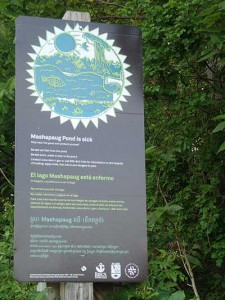A few weeks ago, CLF initiated a lawsuit that seeks to require EPA to do its job under the Clean Water Act and clean up stormwater pollution in Rhode Island. This lawsuit has the potential to be a very big deal.
What is stormwater pollution?
When heavy rain falls and snow melts, water runs across paved surfaces, picks up nasty pollutants like oil, feces, and heavy metals, and eventually flows into Rhode Island’s ponds and rivers, the Narragansett Bay, and the Atlantic Ocean. Rhode Island is densely populated, has a lot of paved surfaces – about 12% of the state, in fact – and there’s not a spot in this tiny, coastal state that’s far from water. This means that there’s a lot of polluted runoff flowing into a lot of water bodies in Rhode Island. Because of stormwater pollution, many of Rhode Island’s ponds and rivers are not fit for swimming, fishing, or even serving as wildlife habitat.

Mashapaug Pond is so polluted that it’s closed to fishing and swimming. CLF’s suit is a critical step in helping restore the ailing pond to health.
That sounds bad.
It is! And it’s worse some places than others. For example, stormwater pollution causes algae growth in Providence’s Mashapaug Pond, choking aquatic life and – because of highly toxic blue-green algae – making the pond unfit for human contact.
On Aquidneck Island, stormwater pollution causes high bacteria levels in Bailey’s Brook. The polluted water from the Brook flows through North Easton Pond and South Easton Pond and ends up at Newport’s very popular First Beach. As a result, the water at First Beach is rarely clean and the state Department of Health must close the beach several times each year during the busy summer season. These situations aren’t unique; other water bodies near Mashapaug Pond and on Aquidneck Island suffer similar harm as a result of stormwater pollution.
How do we know all this?
In legally required studies and analyses, Rhode Island’s Department of Environmental Management (DEM) has documented just how stormwater is harming Mashapaug Pond, Bailey’s Brook, North Easton Pond, and other nearby water bodies. In particular, DEM has concluded that these water bodies have been damaged by stormwater runoff from heavily paved commercial and industrial properties. EPA has formally approved each of these DEM studies after careful consideration.
So what’s the lawsuit all about?
When EPA approved the DEM studies for Mashapaug Pond, Bailey’s Brook, North Easton Pond, and other nearby water bodies, it legally determined that stormwater runoff from commercial and industrial properties was harming these water bodies. Under the Clean Water Act, this kind of determination means that these commercial and industrial dischargers must apply for permits for their stormwater discharges. And under EPA’s own Clean Water Act regulations, the agency must notify the dischargers that they need permits.
EPA hasn’t done this. CLF is suing to make sure EPA does its job.
That all sounds kind of abstract.
CLF’s success in this case will result in major and very tangible benefits. When commercial and industrial stormwater dischargers enter the Clean Water Act’s permit program, they have to take steps to clean up their stormwater discharges. In Rhode Island, this stormwater permitting program is managed – and managed well – by DEM. CLF’s lawsuit would likely result in hundreds of new dischargers entering the stormwater permitting program.
This means much less pollution flowing into water bodies like Mashapaug Pond, Bailey’s Brook, and North Easton Pond. The long-term result will be swimmable, fishable waters that provide suitable habitat for wildlife. And that would be a very big deal.
For more background information please see Conservation Law Foundation’s briefing on stormwater pollution in New England, “Closing the Clean Water Gap: Protecting our Waterways by Making All Polluters Pay.”